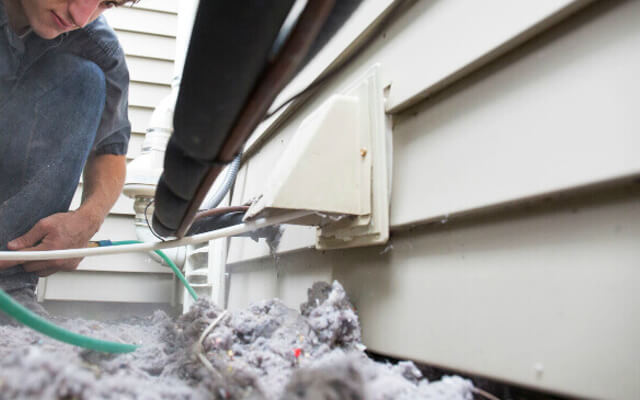Contents
- Introduction
- How Does a Clogged Dryer Vent Happen
- The Dangers of a Clogged Dryer Vent
- These are indications that your dryer’s vent is clogged
- Is there anything you could do
- Summary
Dryer vents can become clogged or dusty over time. Much of what we carry in our pockets or on our bodies ends up in the washing machine, along with lint from clothing, human hair, and animal hair. Lint and dust are produced while our clothes tumble around in the dryer. As the dryer’s exhaust air goes through the ventilation system, it picks up moist lint and debris. Lint tends to stick to the outside surfaces of the ventilation system because it is wet. Lint accumulation over time can reduce air flow, making the dryer work harder and perhaps restricting air flow entirely.
Because your dryer vents are clogged, heated air is unable to leave. As a result, wet air is entering the house. As a result, you may get mold problems. It is possible, however, that this problem is the result of allergy issues.

Lint
How Does a Clogged Dryer Vent Happen
It is normal for a dryer vent to become clogged with lint, causing additional wear and tear on the dryer’s components and necessitating costly repair. During the drying process, air is drawn in from behind the dryer. To circulate the air, a comparable element to that found in an oven is employed. It then passes through the ventilation system and the tumble-dried clothing. If the hot air is restricted or has nowhere to go, the dryer begins to heat up. As a result, the air within the dryer heats up, but the garments remain damp due to no moisture release from the vents. Sensors begin to blow as soon as the dryer reaches a specified temperature. As a result, repair costs can be prohibitively high.
Furthermore, because the airflow of a dryer is restricted owing to inefficiency, it is forced to consume more energy, which may result in a higher gas or electric cost.
The Dangers of a Clogged Dryer Vent
Lint-clogged dryer vents can potentially cause an instant fire hazard due to lint’s high flammability. Lint will generally accumulate around the dryer if the dryer vent is plugged. Lint is sucked up via the heating element in a dryer while the dryer draws air to be heated. This can result in a major fire hazard.
These are indications that your dryer’s vent is clogged
- Towels and jeans require many drying cycles.
- The dryer is emitting a lot more heat than usual.
- The temperature in the dryer is higher than usual.
- When you use the dryer, the windows in your home become fogged up.
- In your laundry room, a considerable amount of lint has accumulated.
- While the machine is turned on, the exterior dryer vent does not open.
- It may even sound like birds are chirping in your vent.
Is there anything you could do
- Cleaning the lint trap after each load of laundry is a good idea.
- Inspect the outside vent to see if it is clogged or if birds have made a home in it.
- Examine your dryer for signs of wear and tear. Examine the connections to your dryer, especially the electrical and gas ones.
- Metal hoses should be used to replace any kinked or plastic hoses.
- If your dryer is on, make sure it is checked on a regular basis.
- Maintaining your dryer on a regular basis helps ensure that it works for many years to come.
- There are a variety of monitors on the market that can assist you in keeping your dryer vents in good working order. These monitors show the air pressure in your vents and alert you when it’s time to clean the ventilation system.

Maintenance
Most manufacturers are required to execute inspection and maintenance on a regular basis. They recommend that you get your dryer vents professionally cleaned every 12 to 18 months. Professionals can clean up all of the lint that has built up in your ventilation system and dryer. It is also suggested that you have your dryer inspected by a professional to ensure that it is operating efficiently and safely.
It is typical for lint to accumulate in a dryer vent. Due to the high flammability of lint, clogged dryer vents can potentially cause an instant fire threat. Lint collection over time can impede air flow, making the dryer work harder and, in some cases, completely preventing air movement. It’s a good idea to clean the lint trap after each load of washing. Lint that has accumulated in your dryer and vent system can be removed by a professional. A specialist should also inspect your dryer every 12 to 18 months.
Please call Canada’s Best Duct for inexpensive and high-quality air duct and furnace cleaning services. Cleaning infinite vents is included in their extremely inexpensive pricing. Edmonton, Red Deer, Penhold, Springbrook, Joffre, Delburne, Sylvan, Lake, Elk, Rimbey, Bently, Lacombe, Blackfalds, Leduc, Beaumont, Sherwood Park, and St. Albert are all serviced regions.

